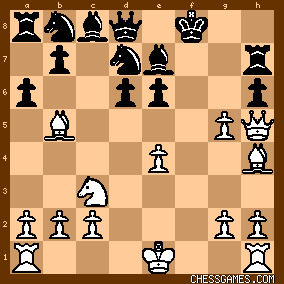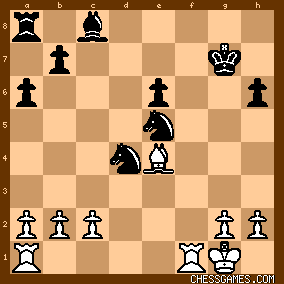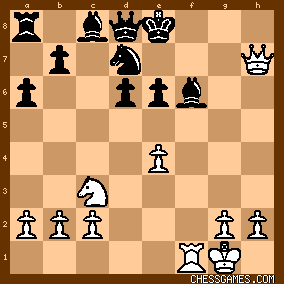|
< Earlier Kibitzing · PAGE 2 OF 2 ·
Later Kibitzing> |
| Nov-29-05 | | Brown: <aw1988>
*puzzled* |
|
| Nov-29-05 | | aw1988: Never mind, I have a horrible sense of humor. |
|
| Dec-07-06 | | joelsontang: is 11.Qh5 a refutation of the goteberg variation? since the opening book 'basic chess openings' says it is. in 'complete chess games of the american world chess champion', by lou hays, it also says 11.Nxe6?, but 11.Qh5  . so is black's position still playable after 11.Qh5? . so is black's position still playable after 11.Qh5? |
|
| Dec-08-06 | | RookFile: No, 11. Qh5 is not a refutation.
O Maiorov vs Sadvakasov, 1996 |
|
| Jul-26-07 | | Owl: Svetozar Gligoric is Serbing he is not Argentinaian |
|
Jul-26-07
 | | plang: <Svetozar Gligoric is Serbing> Which galaxy is that in? |
|
| Jul-13-08 | | offtherook: <joelsontang: is 11.Qh5 a refutation of the goteberg variation?> I have some analysis from Geller that claims this line is a forced draw because White must take perpetual check after the attack can not defeat proper defense. Geller was actually the first to play the knight sac (the three Soviet players Geller, Keres, and Spassky vs the 3 Argentines Najdorf, Pilnik, and Panno at the Interzonals looked off each others positions on the demonstration boards after they were surprised by this novelty the Argentines had worked together on- played simultaneously on 3 boards in the same tournament!) but his later analysis says that White has to look elsewhere because the 11 Qh5 line is a forced draw. I like to play this as Black because once I know the theory, I have at least a draw and there is a good chance of my opponent messing up and letting me win. |
|
Sep-02-08
 | | chancho: Photo of this game:
http://canal-h.net/webs/rguerrero00... |
|
| Jan-17-09 | | nhat8121: http://chessbase.com/newsdetail.asp... |
|
| Sep-17-09 | | timhortons: <HEMATEme>
this is what cg user <zanshin> say about what you ask me> I went through the rest of the game more quickly and found evaluations ranged from -0.2 to +0.4. At the end of the game, it was about +0.09. So I have to conclude that Rybka evaluated the game as pretty much a draw from beginning to end. <hemateme>..everything is debatable here at chessgames.com, but one thing i know is that zanshin is better qualified than me in using chess software in analyzing games. i hope this offer you help... |
|
| Mar-12-10 | | rapidcitychess: For Questions on this complex variation, go to B99 page.Sicilian, Najdorf, 7...Be7 Main line (B99) |
|
| Mar-12-10 | | rapidcitychess: Shams told an old dude how it is done. |
|
| Jun-23-10 | | polarmis: There seems to be a different story behind this game than the one mentioned in the Chessbase article. I just translated an interview with the now 87-year-old Gligoric where he talks about how his friendship with Fischer began at this tournament. The line in the game surprised Gligoric not because it was new to him but because Fischer had actually shown it to him and asked his opinion shortly beforehand! <I considered it my duty to take care of Bobby; he was 15, while I was 35. We spent a lot of time together. Once we were by the river, swimming and sunbathing. I was a good swimmer but Bobby tried to outswim me. And then sulked when he didn’t succeed. I told him: “Bobby, you need to train for about 20 years – and then you’ll beat me!” There, by the river, Fischer asked my opinion about a variation in the Sicilian Defence where white sacrifices a piece and develops an extremely strong attack on the black king. And it must be said that even then Bobby was already up-to-date with everything that was going on in the chess world. Everywhere he went he carried a pocket chess set. So he showed me a game, played somewhere in a minor tournament in Siberia, and asked what I thought about the rook move he was analysing. Imagine my amazement when in the 21st and final round of the Interzonal Tournament in Portoroz I played Fischer and he played the line that he’d shown me by the river! And not just that, he made the same move that I hadn’t considered worthy of my attention! I got a draw with white, but nevertheless I have to admit that in the final position where I had three pawns for a piece Fischer was better. It was just that by that time we both knew that we’d qualified to take part in the World Championship: I was second behind Tal, while Fischer was sharing 5th place.>
http://www.chessintranslation.com/2... |
|
| Dec-02-11 | | Robeson: Thanks to the guys who linked to the outside stories, especially the relatively recent interview with Glig. I'd like to add a bit to the story of Fischer asking him about the variation in question. On a break from swimming, Bobby asked him about it, as he already liked and respected Gligoric. There was no reason why Glig should think of it one way or the other, as no one was playing it then, as Geller's incredible Bb5!! in the "triple game" was thought to refute the line. Even at that young age, Bobby already had the belief that people have ulterior motives that they conceal to gain an advantage. He took Gligoric's "eh, dunno" reaction as prima facie proof of Glig's professional caginess and smarts. "Naturally" a player as strong as Glig must have analyzed it and have strong opinions that Bobby would only learn OTB! The result was this game. The English title of Gligoric's excellent 2003 autobiographical games collection is "I Play Against Pieces", while the Spanish edition is the more natural sounding "I Play Against The Pieces". When I first heard that title, I thought it sounded really cool and that Gligoric meant that he targeted pieces rather than pawn structure, as most GMs do. In fact, it means the more mundane and usual "I play the board, not the man." I highly recommend it. New copies go for obscene prices but it can still be found on a well-known book selling website for around $25 American, plus a few more books S&H. Do yourself a favor and buy it today. |
|
| Apr-21-12 | | JohnDahl: Another photo: http://www.chesshistory.com/winter/... |
|
| Feb-14-14 | | Cemoblanca: So that was the famous "river variation" of Bobby back then. Very interesting game. Just checked out a drawish line after 32.Qe3, for example: 32...Kg7 33.e5 Qe7 34.exd6 Rxd6 35.Re1 Qd7 36.Ne4 Rd1+ 37.Rxd1 Qxd1+ 38.Kb2 Qd5 39.Nc5 Bf5 40.c4 Qg2+ 41.Ka3 Qxh2 42.Nxb7 Bb1 43.Qd4+ Kh7 44.Qa1 Qh1 45.Nc5 Qe1 46.Ka4 Ne5 47.Qd4 Qe2 48.Nxa6 Qxa2+ 49.Kb5 Qxb3+ 50.Nb4 Nd3 51.Qh4+ Kg6 52.Qg4+ Kf6 53.Qd4+ Kg5 54.c5 Nxb4 55.Qh4+ Kf5 56.Qf4+ Ke6 57.Qg4+ Ke5 58.Qf4+ Ke6 59.Qg4+ Ke7 60.Qxb4 Bd3+ 61.Ka5 Qd5 62.Kb6 Be4 63.c6+ Ke6 64.Qc5 Qxc5 65.Kxc5 Bxc6, etc. Back then Gligo admitted that, the final position where he had 3 pawns for a piece, Bobby had the slightly better game. Well, when he said better he probably meant, that White had to do more for the draw then Black & in such situations an error happens faster than you think. |
|
| Nov-13-15 | | Howard: Anyone wanna run this through an engine ? Gligoric's play could have been improved starting around move 14, I've heard. |
|
| Feb-25-16 | | Howard: Let me repeat: anyone care to do an engine test on 14.O-O ? |
|
| Feb-26-16 | | NeverAgain: <14.0-0+> is the main line of the Gothenburg Var section in Nunn's "The Complete Najdorf: 6.Bg5" (1997, The American Batsford Chess Library/ICE, ch.15 '6.Bg5 Other Lines', section E, p.312). In the introduction to this section the author states that "[the] line is unpopular today, but there seems to be no objective reason for this". He goes on to say that <11.Nxe6> (after 10...Nfd7) "is thought to be a forced draw", while <11.Qh5>, "although avoiding the draw, also seems to give White no advantage". In a testament of Nunn's reputation as a quality chess author, twenty years later top engines largely agree with his assessments. The position after Fischer's crucial novelty <13...Rh7!>:

click for larger viewStockfish 7 prefers <14.e5> to the immediate castle-check; it doesn't find more than equality in either case, though. Analysis by Stockfish 7 64 POPCNT (11 threads @3.2GHz, Hyperthreading off, 8GB hash table): 14.e5 Nxe5 15.0-0+ Kg8 16.g6 Bxh4 17.gxh7+ Kxh7 18.Bd3+ Kg7 19.Ne4 Nbc6 20.Nxd6 Qxd6 21.Qxh4 Qd4+ 22.Qxd4 Nxd4 23.Be4
= (0.21) Depth: 40/72 00:37:51 32195MN, tb=126621 (Since it's common for the engines' PVs to generate into nonsense halfway through, I double-checked the above line by sliding forward every three plies and letting the iteration count to run to 40 again. Although the PV ran to move 43 I picked <23.Be4> as a reasonable endpoint of the analysis) 
click for larger viewWhite has the better pawn structure, and a rook and a pawn; Black has a centralized knight pair supported by a central pawn. It's hard to imagine a grandmaster losing the Black side of this position except for psychological reasons. [to be continued] |
|
| Feb-26-16 | | NeverAgain: Next I set Houdini 4 Pro x64 in Tactical Mode (slower, wider search tailored to unearthing hard-to-find tactical shots) upon <14.0-0+>. Two hours and two hundred billion nodes later it duplicated Nunn's main line until move 20 (!) but the discrepancy turned out to be insignificant - White still doesn't seem to have anything better than a perpetual. Analysis by Houdini 4 Pro x64 B:
14...Kg8 15.g6 Rg7 16.Rf7 Bxh4 17.Qxh6 Rxf7 18.gxf7+ Kxf7 19.Rf1+ Bf6 20.Qh7+ Ke8 21.Qg6+ Kf8 22.Bxd7 Nxd7 23.Qh6+ Ke8 24.Qg6+ Ke7 25.Qh7+ Ke8 26.Qh5+ Ke7 27.Qh7+ Ke8
= (0.00) Depth: 31/91 02:25:52 201514MN, tb=634 
click for larger viewAfter <17...Rxf7> Nunn states: "According to current theory this moves leads to perpetual check" and discusses an attempt by Black to avoid that with <17...Qf6>, citing Skrobek-Inkiov, Polanica Zdroj 1981, and Diaz-Alzate, Bayamo 1984 as well as some original analysis. His conclusion is that "by avoiding the draw, Black risks falling into an inferior position". His main variation matches Houdini's PV until <20.Qh7+>

click for larger view
where he gives <20...Kf8!> with the following note: "Better than 20...Ke8 21.Qg6+ Kf8 22.e5 dxe5 23.Ne4 Qb6+ 24.Kh1 axb5 25.Nxf6 Ke7 26.Qe8+ Kd6 27.Qxc8 ...

click for larger view
27...Nxf6 30.Qf8+ Kd5 31.Qxf6 with a very favourable ending." However, in the diagrammed position Black doesn't have to take the f6 knight - <27...Ra4! Δ...Rf4> and if anything, SF7 gives Black a microscopic edge: = (-0.07) Depth: 40/69 00:07:17 7975MN, tb=3480320 So, while the engines consider 20...Ke8 and 20...Kf8 roughly equivalent, Nunn wraps up the subsection with "After 20...Kf8! White might as well take the draw straight away. Although various winning attempts have been tried, close examination shows that White only risks losing if he tries one of these", citing a couple of ideas by Beliavsky and by Geller, as well as improvements on own analysis in 'The Najdorf for the Tournament Player' (1988). He ends the section with the conclusion that "the only thing wrong with the Gothenburg variation is that White has a forced draw". This variation appears to be heavily analyzed on Chessbase Let's Check. The engines range from Deep Fritz 13 to recent Stockfish dev builds and the depths from 24 to 45; my impression after cursorily browsing through the subvariations stemming after <13...Rh7!> is that nowhere White has more than a +0.15 edge, with most evals hovering just around zero. |
|
| Mar-08-16 | | Howard: Thanks very, very much NeverAgain! So, it appears that the triple-massacre at the 1955 interzonal, was indeed avoidable on the part of the Argentines. |
|
| Apr-02-16 | | diceman: <Howard: So, it appears that the triple-massacre at the 1955 interzonal, was indeed avoidable on the part of the Argentines.> If they were Fischer. :) |
|
Oct-30-18
 | | scormus: <NeverAgain> great analysis and discussion, thanks! The question of whether or not to play Nxe6 in these type of positions must have come to most 1. e4 players. It's hard to resist such a move. I was in a somewhat similar game recently and had the chance to get 3p plus initiative for the piece. To my shame I chickened out and did not play it. Bu this is what I love about the Najdorf - B says to W "OK do your worst but I can take it and likely come back and bite you." |
|
| Nov-19-18 | | balanced: 20...Kf8! as given by Nunn was the reason I was published in New in Chess YB 48. As this was considered the mainline I titled the article "The Gothenburg Bust". After 20...Kf8! I gave the refutation 21.e5 dxe5 22.Be2 Qb6+ 23.Kh1 Ke8 24.Qg8+ Ke7 25.Rd1 Nf8 26.Ne4 Nbd7 27.Nxf6 Kxf6 28.h4 Qe3 29.Bh5 Ke7 30.Qf7+ Kd8 31.Qxf8+ Kc7 32.Qd6+ Kd8 33.Rf1 Qh6 34.g4 a5 35.g5 Qh8 36.g6 Ra6 37.Rf8+ Qxf8 38.Qxf8+ Nxf8 39.g7 A beautiful end to 20...Kf8 Also worth noting is if instead of 34...a5, say 34...b5 then 35.g5 Qh8 36.g6 Bb7+ 37.Kg1 Qh6 38.Rf7 Qc1+ 39.Bd1 Qe3+ 40.Kh2 and the end is near. |
|
| Apr-19-19 | | NeverAgain: Congratulations on being published and thank you for the headsup, <balanced>. Yes, 20...Kf8 turned out to be bad. 21.Be2 Δ Bh5 is another winning move for White here. 20...Ke8 still appears to hold all the way to 27...Ra4, though, so the Gothenburg is far from being busted. |
|
 |
|
< Earlier Kibitzing · PAGE 2 OF 2 ·
Later Kibitzing> |





